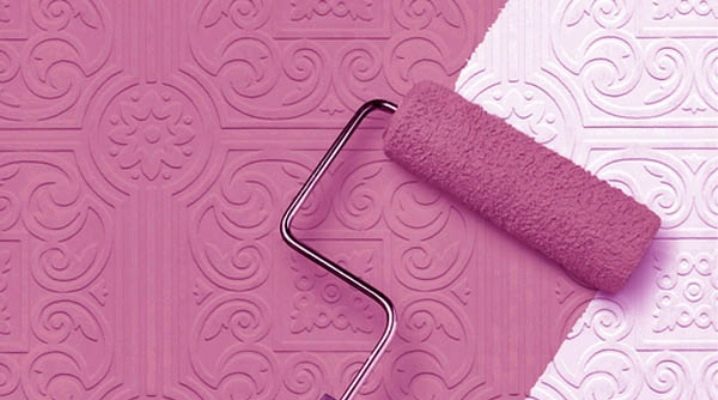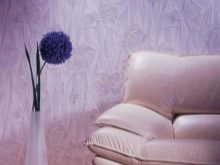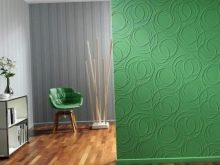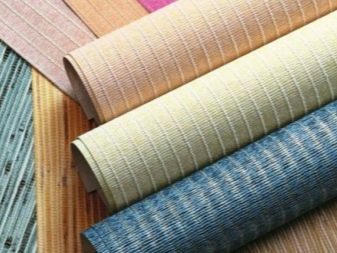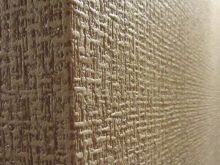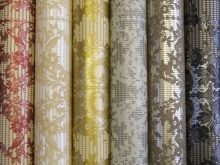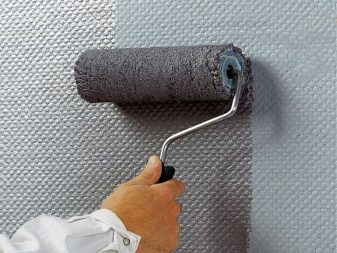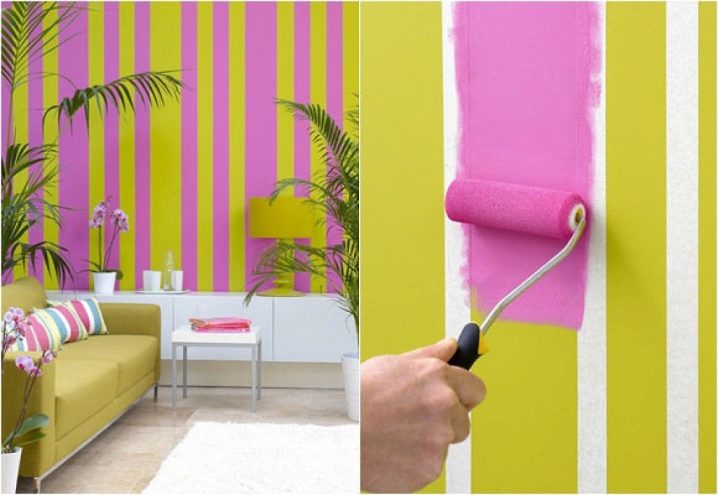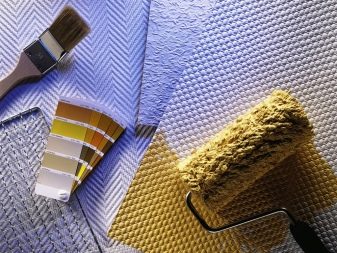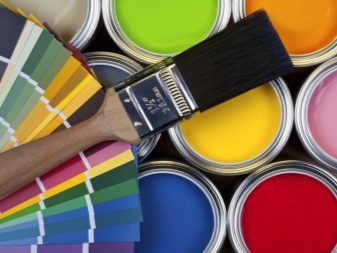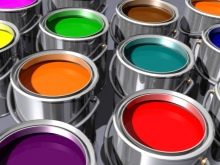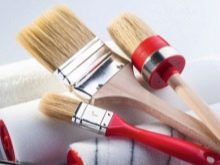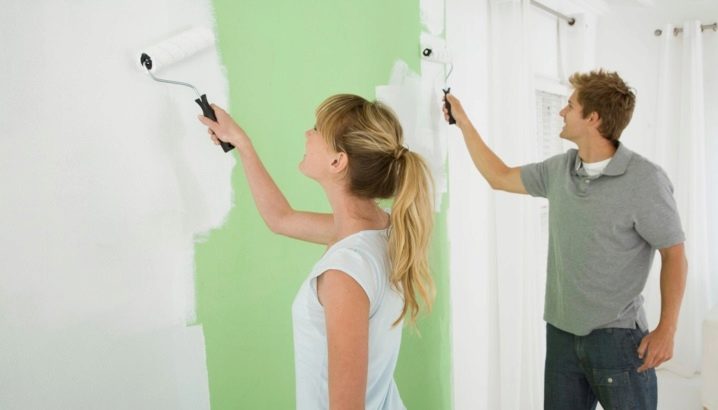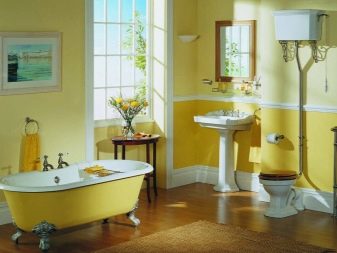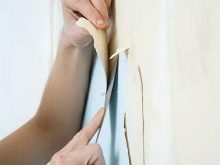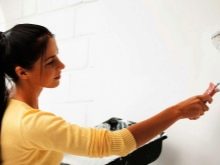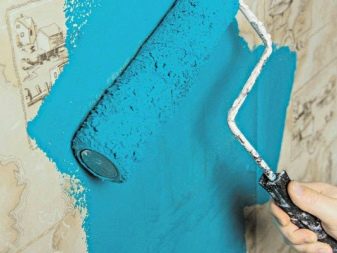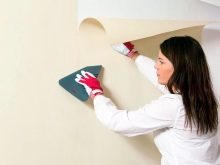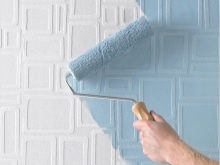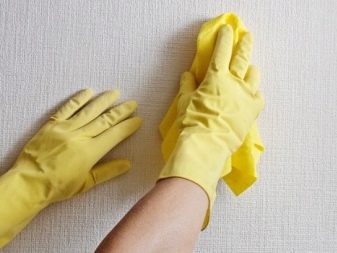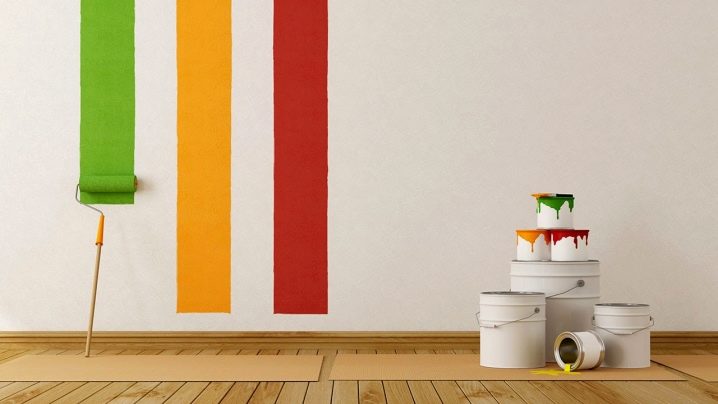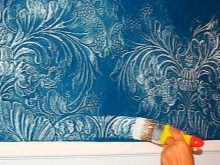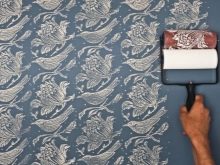Is it possible to paint the wallpaper and how to do it?
Wallpapers are the most common material for decorating walls. The modern look of wallpaper for painting has become a real boon for apartment owners. Such wallpaper can be painted, and not once. All this allows you to change the color atmosphere of the room, and at the same time significantly save financially.
Features and types of coverage
Today there are several types of wallpaper, of which only vinyl and non-woven are suitable for dyeing.
If the second option is suitable for all types of staining, then with the first type some questions may arise. Such wallpaper is a material of two layers: paper or non-woven (base wallpaper) and PVC film (top layer).
It is customary to distinguish three main types of vinyl wallpaper:
- Foamed. These wallpapers have a more dense top layer, they are more resistant to coloring matter.
- Flat. Such wallpapers are distinguished by a thin top layer, which in composition may have a different matter (for example, silk fibers). They are produced using hot stamping techniques, are a good decorating material and do not need additional changes in the form of dyeing.
- Dense or moisture resistant. This type has a more dense PVC film, which allows it to withstand wet cleaning of the surface. Because of these qualities, the paint will not be able to get into the middle of the material and harden on the surface.
Paper-based wallpaper immediately disappears when choosing for painting. The paper base can swell, and as a result, the deformation of the wallpaper and their peeling will occur. In turn, the material on non-woven base is more resistant to moisture and coloring matter. Non-woven base will not allow to deform the wallpaper and allow the paint to evenly settle on the surface.
From the foregoing it follows that you can paint the wallpaper, but only vinyl on non-woven base.
These wallpapers have the following advantages:
- Strength, which is achieved by high-density wallpaper. This makes it difficult to deform and damage the surface.
- High moisture resistance. They tolerate wet cleaning.
- Resistant to sunlight. This fact allows you to save color for a long time and do not fade.
- Wide range of. You can find wallpaper with both smooth and embossed surface. Species with different patterns and in different colors.
- Good hold on any surface. They can be glued even on concrete walls.
This type of material has a drawback - poor air conductivity. This can adversely affect the walls or ceiling, if they are pasted over with such wallpaper without prior treatment from fungi. In general, vinyl wallpapers are a good option for coloring. It should take into account some of the nuances.
Nuances of staining
The process of coloring wallpaper consists of the following stages of work:
- The right tool for painting.
- Choosing the right paint.
- Proper preparation of the walls.
For painting vinyl wallpaper will require a roller and brushes, the pile height of which can vary.For monochromatic dyeing it would be advisable to use a roller of medium size. It will allow in a short time to paint a large surface. To highlight the surface topography or to apply the pattern, use brushes of different widths and stencils. They will allow more accurate and accurate transfer of the picture.
In order to choose the paint, you should consider several factors:
- Dye, in the first place, should not be toxic, since the work is carried out indoors.
- Only an aqueous solvent will be suitable for coloring wallpaper, which does not violate or deform the wallpaper structure.
Based on these factors, the most suitable substances for decoration are:
- water paint;
- acrylic paint;
- latex dyes.
Aqueous emulsion paint is best used in a bedroom or children's room, as it can be used to produce muted and soft shades. The surface becomes matte, which allows you not to leave handprints, this is especially important for a child's room. The only negative staining with such paint is a further ban on wet cleaning.
Acrylic paint allows the surface to dry very quickly, on average in 4–5 hours. Therefore, it is most often chosen by those who are limited in repair on time. This paint fits well, and the surface takes on a soft glossy look. In this case, such a wall can be cleaned with a damp cloth.
Latex dyes are most often used in the bathroom, in kitchens and hallways, as they can be washed. They also do not absorb dirty, oily stains, which allows them to quickly and easily wipe off the surface. Walls from such dye get a glossy look. This paint is good to put patterns and drawings.
Before you start painting the wallpaper, they should be glued to the wall.
And for a strong and effective result, it is necessary to properly prepare the wall:
- First you need to remove the old wallpaper and cover up the cracks, if any.
- After the work done, it is important to treat the walls with a primer. It allows you not to crumble particles of old paint, concrete. Another solution for priming allows you to create a special film on the surface of the walls, which increases the adhesion effect. This allows subsequent layers of the solution or vinyl material to better and more firmly consolidate on the surface.
- An important point is the treatment of the wall with a special solution from mold and fungi. After all the subtleties and nuances are taken into account, you can proceed directly to the process of coloring wallpaper.
The process of registration
The process of coloring wallpaper can be approached in the traditional and alternative way.
In this regard, the following options are highlighted:
- Coloring the outside of the wallpaper.
- Repainting old wallpaper.
- Coloring of a seamy side.
- Combined method of staining.
To begin with, wallpaper is stuck on the wall. For this it is best to use glue for heavy materials or special for non-woven base wallpaper.
After the walls are “dressed”, you must give them to dry thoroughly (1-2 days). Then the surface of the material is degreased, removes dirt and dust. Only then can you begin to paint the surface, which is best done with a roller.
The process is the same as painting any other surface. If it is necessary to apply a second layer, you should wait until the first layer is completely dry (approximately 2-3 hours).
Repaint old vinyl wallpaper is not difficult, you only need to clean the surface from dust and degrease it. This can be done with regular soapy water.Soak the rag in such a solution and thoroughly wipe the walls. Once the walls are dry, you can begin to change color. This method does not differ from the traditional painting of the surface.
The only thing you should pay attention to is the original color of the wall material. If there was a dark shade, it is unlikely that it will be possible to repaint the surface in a cardinally light tone.
It is better to use a more saturated color and try to play on the contrast of the surface gloss. If the walls were originally matte, then during the repainting it is better to create a gloss on the surface using a more dense paint.
Coloring the wrong side is a modern way to change color. For this staining is exposed non-woven base. Before pasting the walls, the wrong side should be coated with the desired paint and allowed to dry. After that you can stick them on the wall.
Then you can leave the wall in this state and after a while the color will appear. And you can apply paint on the outer surface and, without letting it dry, erase it with a damp cloth or draw a picture. This method will allow you to get an unusual and volumetric effect on the wall.
The combined staining method is the most time consuming, but the result is spectacular and impressive. To do this, embossed wallpaper or material with a pattern is covered with paint, and then details of the relief or pattern are written with a thin brush.
For this method it is best to take contrasting colors and type of paint. If the main paint has a matte effect, then it is better to draw patterns with gloss paint.
Coloring the wallpaper today is not unusual. It is rather a standard procedure for changing the decor of the interior. Only for the desired and durable result it is necessary to take into account all the nuances.
On how to properly paint the wallpaper, you can learn from the following video.
